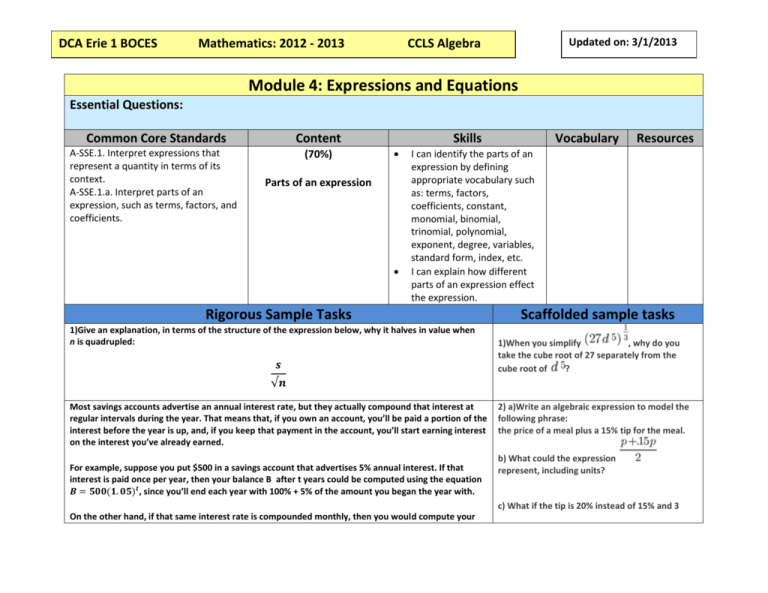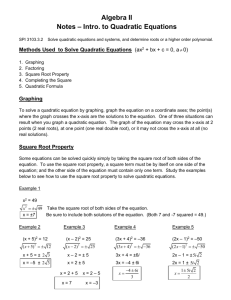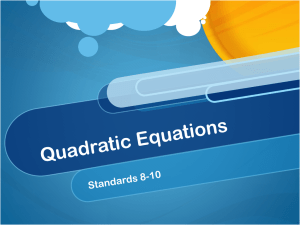Algebra Module 4
advertisement

DCA Erie 1 BOCES Mathematics: 2012 - 2013 Updated on: 3/1/2013 CCLS Algebra Module 4: Expressions and Equations Essential Questions: Common Core Standards Content A-SSE.1. Interpret expressions that represent a quantity in terms of its context. A-SSE.1.a. Interpret parts of an expression, such as terms, factors, and coefficients. (70%) Skills Parts of an expression Vocabulary Resources I can identify the parts of an expression by defining appropriate vocabulary such as: terms, factors, coefficients, constant, monomial, binomial, trinomial, polynomial, exponent, degree, variables, standard form, index, etc. I can explain how different parts of an expression effect the expression. Rigorous Sample Tasks 1)Give an explanation, in terms of the structure of the expression below, why it halves in value when n is quadrupled: 𝒔 Scaffolded sample tasks 1)When you simplify , why do you take the cube root of 27 separately from the cube root of ? √𝒏 Most savings accounts advertise an annual interest rate, but they actually compound that interest at regular intervals during the year. That means that, if you own an account, you’ll be paid a portion of the interest before the year is up, and, if you keep that payment in the account, you’ll start earning interest on the interest you’ve already earned. For example, suppose you put $500 in a savings account that advertises 5% annual interest. If that interest is paid once per year, then your balance B after t years could be computed using the equation 𝑩 = 𝟓𝟎𝟎(𝟏. 𝟎𝟓)𝒕 , since you’ll end each year with 100% + 5% of the amount you began the year with. 2) a)Write an algebraic expression to model the following phrase: the price of a meal plus a 15% tip for the meal. b) What could the expression represent, including units? c) What if the tip is 20% instead of 15% and 3 On the other hand, if that same interest rate is compounded monthly, then you would compute your DCA Erie 1 BOCES Mathematics: 2012 - 2013 balance after t years using the equation 𝑩 = 𝟓𝟎𝟎(𝟏 + Updated on: 3/1/2013 CCLS Algebra people are sharing the cost evenly. How can you represent the amount each person pays with a simplified algebraic expression? Identify the units for the expression. .𝟎𝟓 𝟏𝟐𝒕 ) 𝟏𝟐 1. Why does it make sense that the equation includes the term .05 by 12? 2. 3. 4. .𝟎𝟓 𝟏𝟐 ? That is, why are we dividing How does this equation reflect the fact that you opened the account with $500? .𝟎𝟓 .𝟎𝟓 What do the numbers 1 and represent in the expression (𝟏 + )? 𝟏𝟐 𝟏𝟐 What does the “12t ” in the equation represent? A-SSE.1.b. Interpret complicated expressions by viewing one or more of their parts as a single entity. For example, interpret P(1+r)^n as the product of P and a factor not depending on P. (70%) Interpreting expressions I can identify the factors of an expression. I can describe the effects of the parts of an expression (examples: the interest formula where p is a coefficient and when factoring a quadratic equation, the GCF does not affect the roots). Rigorous Sample Tasks Suppose P and Q give the sizes of two different animal populations, where Q>P . In (a)–(d), say which of the given pair of expressions is larger. Briefly explain your reasoning in terms of the two populations. 1. 2. 3. P+Q and 2P 𝑷 𝑷+𝑸 and 𝑷+𝑸 (𝑸−𝑷) 𝟐 and 𝟐 𝑸−𝑷 𝟐 Scaffolded sample tasks 3) Given the expression: a)What is the degree of this expression? b)What is the largest coefficient? DCA Erie 1 BOCES 4. Mathematics: 2012 - 2013 Updated on: 3/1/2013 CCLS Algebra 𝑷 + 𝟓𝟎𝒕 and 𝑸 + 𝟓𝟎𝒕 c) What is the leading coefficient of the polynomial in standard form? d) How many terms are in the polynomial? A-SSE.2. Use the structure of an expression to identify ways to rewrite it. For example, see x^4 - y^4 as (x^2)^2 - (y^2)^2, thus recognizing it as a difference of squares that can be factored as (x^2 - y^2)(x^2 + y^2). (70%) Structure of expressions I can rewrite an expression using laws of exponents. I can factor an expression by grouping (GCF). Rigorous Sample Tasks Factoring by grouping Laws of exponents Difference of squares and cubes Structure Scaffolded sample tasks Rewrite the polynomial such that it has more terms than the original expression. Why is the expression not the correct factored form for ? You purchase n cans of tennis balls at $4.50 per can from an online retailer. There is a tax of 8% on your order. There are also shipping costs of $7.00 per order. Write the expression that can be used to find the total cost. Rewrite the expression in an equivalent form. Simplify the expression ways. Justify each step. in two different You burn calories at a rate of 15 calories per minute when running and 6 calories per minute when walking. Suppose you exercise for 60 minutes by running for r minutes and walking for the remaining time. The expression 15r+6(60-r) represents the calories burned. a) What units are associated with r? What units are associated with 15? What does 15r represent? Use unit analysis to explain. DCA Erie 1 BOCES Mathematics: 2012 - 2013 Updated on: 3/1/2013 CCLS Algebra b)What does 60-r represent? What units are associated with 6(60-r)? c) Simplify 15r+6(60-r) . What units are associated with the expression? Use unit analysis to explain. A-SSE.3. Choose and produce an equivalent form of an expression to reveal and explain properties of the quantity represented by the expression. A-SSE.3.a. Factor a quadratic expression to reveal the zeros of the function it defines. (20%) Factoring Quadratics Rigorous Sample Tasks I can factor quadratic expressions (Greatest Common Factor, Difference of two perfect squares, and reverse distribution). Reverse distribution Scaffolded sample tasks What critical features of the function will be revealed when written in factored form? DCA Erie 1 BOCES Mathematics: 2012 - 2013 Updated on: 3/1/2013 CCLS Algebra Given the following expressions, rewrite them in an equivalent form. a) b) c) A student deposits $500 into an account that earns 3.5% interest compounded quarterly. Describe and correct the student’s error in calculating the account balance after two years. IV) Does the function represent exponential growth or decay? Justify your reasoning. V) Write the function form with a different base. A-SSE.3.b. Complete the square in a quadratic expression to reveal the maximum or minimum value of the function it defines. (20%) Complete the square I can factor quadratic expressions by completing the square. I can explain what different forms of a quadratic expression reveal about the function. I can write a quadratic Complete the square Vertex form Standard form in an equivalent DCA Erie 1 BOCES Mathematics: 2012 - 2013 Updated on: 3/1/2013 CCLS Algebra expression in vertex form to reveal the maximum or minimum value of the function. Rigorous Sample Tasks Scaffolded sample tasks What critical features of the function will be revealed while completing the square? A-SSE.3.c. Use the properties of exponents to transform expressions for exponential functions. For example the expression 1.15^t can be rewritten as (1.15^(1/12))^12t approximately equals 1.012^12t to reveal the approximate equivalent monthly interest rate if the annual rate is 15%. (20%) Rewriting exponential expressions Rigorous Sample Tasks A-APR.1. Understand that polynomials (70% and Fluency) I can rewrite exponential expressions using laws of exponents. I can rewrite exponential functions to compare and contrast them with other exponential functions. Scaffolded sample tasks I can define the system of Closure DCA Erie 1 BOCES Mathematics: 2012 - 2013 form a system analogous to the integers, namely, they are closed under the operations of addition, subtraction, and multiplication; add, subtract, and multiply polynomials. Operations with polynomials Rigorous Sample Tasks A.APR.3 Identify zeros of polynomials when suitable factorizations are available, and use the zeros to construct a rough graph of the function defined by the polynomial. polynomials as closed under addition, subtraction, and multiplication. I can explain why the operation of division is not defined as closed. I can explain that polynomials can be operated on in the same way as integers. I can add polynomials. I can subtract polynomials. I can multiply polynomials. Analogous Scaffolded sample tasks (20%) Factor quadratics Rigorous Sample Tasks A-CED.1. Create equations and inequalities in one variable and use them to solve problems. Include equations arising from linear and quadratic functions, and simple rational Updated on: 3/1/2013 CCLS Algebra I can factor a quadratic function. I can identify the zeros of a quadratic function algebraically. I can sketch the graph of a quadratic function using the zeros. Zeros Sketch Factorization Scaffolded sample tasks (70%) Writing quadratic equations I can write a linear equation from a word problem. I can write a linear inequality from a word problem. I can write a quadratic DCA Erie 1 BOCES Mathematics: 2012 - 2013 and exponential functions. Rigorous Sample Tasks A-CED.2. Create equations in two or more variables to represent relationships between quantities; graph equations on coordinate axes with labels and scales. Updated on: 3/1/2013 CCLS Algebra equation from a word problem. I can write an exponential equation from a word problem. I can solve a linear equation written from a word problem and interpret its solution within the context. I can solve a linear inequality written from a word problem and interpret its solution within the context. I can solve a quadratic equation written from a word problem and interpret its solution within the context. I can solve an exponential equation written from a word problem and interpret its solution within the context. All with integer exponents. Scaffolded sample tasks (70%) Writing equations I can write linear equations using two or more variables. I can rewrite an equation in terms of one variable (y = form). I can identify parts of the coordinate plane (axes and DCA Erie 1 BOCES Mathematics: 2012 - 2013 Rigorous Sample Tasks A-CED.4. Rearrange formulas to highlight a quantity of interest, using the same reasoning as in solving (70%) Literal equations Updated on: 3/1/2013 CCLS Algebra quadrants). I can graph systems of equations with correct labels and scales from a word problem. I can write quadratic equations using two or more variables. I can rewrite a quadratic equation in terms of one variable (y = form). I can graph a quadratic equation from a table of values with an appropriate scale and labels from a word problem. I can write an exponential equation using two or more variables. I can rewrite an exponential equation in terms of one variable (y = form). I can graph an exponential equation from a table of values with an appropriate scale from a word problem. Scaffolded sample tasks I can rewrite literal equations in terms of a different variable using real world DCA Erie 1 BOCES Mathematics: 2012 - 2013 equations. For example, rearrange Ohm's law V = IR to highlight resistance R. Rigorous Sample Tasks A-REI.4. Solve quadratic equations in one variable. A-REI.4.a. Use the method of completing the square to transform any quadratic equation in x into an equation of the form (x - p)^2 = q that has the same solutions. Derive the quadratic formula from this form. (70%) formulas. I can rewrite equations with squared variables in terms of a different variable. Scaffolded sample tasks Quadratic formula Rigorous Sample Tasks A-REI.4.b. Solve quadratic equations by inspection (e.g., for x^2 = 49), taking square roots, completing the square, the quadratic formula and factoring, as appropriate to the initial form of the equation. Recognize when the quadratic formula gives complex solutions and write them as a plusminus bi for real numbers a and b. Updated on: 3/1/2013 CCLS Algebra I can rewrite a quadratic equation to the form (x - p)^2 = q by using "completing the square" method. I can derive the quadratic formula from "completing the square" method. Quadratic formula Derive Scaffolded sample tasks (70%) Solving quadratic equations I can solve quadratic equations by "completing the square" method. I can solve quadratic equations by factoring. I can solve quadratic equations by applying the quadratic formula. I can solve quadratic equations by inspection (e.g. square rooting both sides). I can explain why quadratic Non-real solution Complex solution DCA Erie 1 BOCES Mathematics: 2012 - 2013 Rigorous Sample Tasks Updated on: 3/1/2013 CCLS Algebra equations have two solutions. I can identify when a quadratic equation gives nonreal/complex solution(s). **Solving and writing complex solutions is not required in Algebra I. Scaffolded sample tasks









